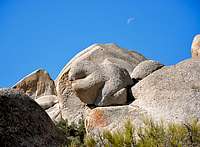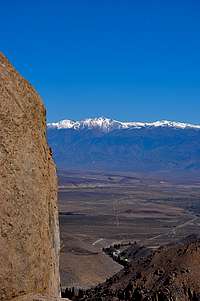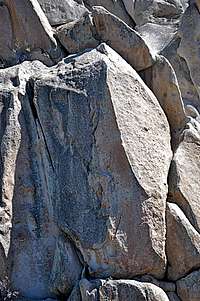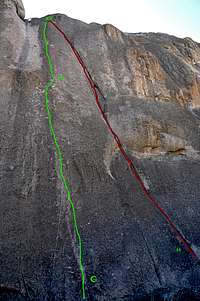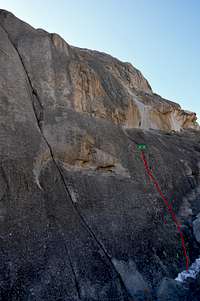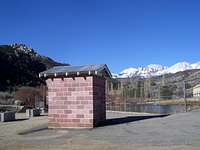-
 12659 Hits
12659 Hits
-
 95.35% Score
95.35% Score
-
 52 Votes
52 Votes
|
|
Area/Range |
|---|---|
|
|
37.30021°N / 118.5218°W |
|
|
Trad Climbing, Sport Climbing |
|
|
Spring, Summer, Fall |
|
|
6800 ft / 2073 m |
|
|
Overview
Little Egypt is a small part of an area known as “Egypt” some eleven miles directly west of the town of Bishop, California.

Little Egypt may not be a huge climbing area, but it has a certain charm that can not be accessed without hiking deep into the wilderness. As you drive west on Highway 168, the last thing on your mind might be to look over your left shoulder to notice a small section of this impressive area peeking out above a none descript ridge. You may be busy driving to your trailhead at South Lake or North Lake. If you have about an hour to explore a new area before heading for the big mountains, you can find a worthy adventure just beyond that none descript ridge. That’s Little Egypt.
Little Egypt consists of three rocky domes/formations that are parallel to each other and west facing. The front tier, the first formation you come to after the initial approach, is the most popular of the three formations. I have submitted two separate pages, Frontier, left side and Frontier, right side are on this front tier. The next formation is Lambada Dome , and finally Mussypotemia
, the last of the three formations.
By all accounts The Frontier formation offers the highest rock quality, therefore the greatest number of climbs. Most of the traditional crack climbs are located on the left side and most of the newer sport routes are on the right. Thanks to the effort of a handful of climbers, this crag now contains some of the best routes in the Little Egypt area. If you are looking for a challenging sport route in the eastern Sierra back country, the Frontier offers one. It’s called “Creme del Este, 13a.” Good Luck.
Lambada Dome is the next formation after the Frontier. This beautiful formation is hidden from view when you are climbing on the Frontier. But when you top out on the two pitch crack climbs of the Frontier, you are suddenly treated to a heart stopping view of Lambada Dome. Unfortunately, due to lower rock quality, the greater portions of this formation remain untouched. There are several routes on the left hand side of Lambada Dome and one in particular takes you all the way to the top of the formation. This climb is called “Walls of Separation, 5.9,” and it’s two pitches long.
The last formation of the Little Egypt group is (Mussypotemia). To approach this formation you need to use some creativity. There are no clear cut trails leading to the base, but the hike is fun none the less. The rock quality on Mussypotemia is similar to that as Lambada Dome, grainy and not very good. Most of the routes are grouped together on the extreme left side, and a few more on the right hand side. There is, however, a very large boulder with two great climbs on it. This boulder is called “Flotilla Boulder” and it’s situated across from the main Mussypotemia formation. Getting to base of this boulder is easy and the two climbs are bolted sport routes.
Frontier, left side
Frontier, left sideIt was not until the the late 1970s to the early part of the 1980s that the first climbs were established on the Frontier. Of the first early hardmen to establish routes on the Frontier’s left side, one was none other than Alan Bartlett with his first ascent of one of the best climbs on the entire formation, Classic Crack, rated 10a. Another climber to establish routes on the Frontier’s left side was, Tony Puppo with his climb of, Hieroglyphics, 5.9. During the 1980s, when sport climbing seemed to keep the younger generation of climbers busy on bolted faces, several of the veteran hardmen were establishing routes on the Frontier’s upper face’s cracks. These cracks were all in the 5.11 difficulty level. True to their principles, these back country climbers did not place any bolts next to cracks. They relied entirely on their own abilities and primitive protections of the era.
Note: There is a third class ramp leading to the base of several of the left side’s upper wall cracks. The same ramp turns into a chimney/corner that may be used to get to the base of “ The Gutter.”
Climbs of The Frontier, left side | |
| A | Dog Day Afternoon, 11d, standard rack, pro to 2.5" |
| B | Espresso Crack, 11c, standard rack, pro to 3 inches |
| C | Hieroglyphics, 5.9, Standard rack, pro to 2.5 inches |
| D | Flight, 10d, bolts and standard rack |
| E | Classic Crack, 10a, Standard Crack, pro to 3.5 inches |
| F | Grain Tamer, 12c, bolts |
| G | The Gutter, 10c, standard rack |
| H | Rosetta Direct, 12b, bolts |
| I | 4 Those About 2 Rock, 10d, standard rack |
| J | Decaf, 11d, standard rack, pro to 3.5 inches |
Frontier, right side
Frontier, right sideAlthough most of the classic lines were established during the late seventies and early eighties, the route development did not stop there. At the present time, you can find a number of more difficult routes on bolted faces leading to excellent anchors for lowering or rappelling down. The old days of finding your way down the back side or making scary rappels off of ratty tree trunks or rattly rock horns are long gone. The fact of the matter is that if you are good enough to crank 5.12 and 5.13s in the back country at seven thousand feet, you should, at least, have the luxury of not having to trudge through obscure trails covered by sand and brush just to get back down. Many old climbers, such as this individual, have come to accept and even embrace the realities of modern day tactics.
Not to be left too far behind the left side classics, the Frontier’s right side has its own share of classic routes dating back to the late seventies and early eighties. One of the early pioneers on the Frontier was none other than Alan Bartlett with his first ascent of “Pyramid Power,” a dihedral crack rated at 5.9. Another crack system that was done in the early days and definitely qualifies as a classic is “King Tut’s Tomb,” rated at 10c.
Although it was the crack systems that received most of the attention at the Frontier during the early years, sport climbing made its own impact soon after. Two of such highly recommended face climbs are “Caravans, 10a” and “Welcome to The Dark Side. 10c.” And finally, for those looking for a challenge in a much higher difficulty level, there is one climb to name, and that is “Creme del Este, 13b,” a masterpiece established by the visionary climber, Kevin Thaw.
The Frontier, right side | |
| A | Cannibal, 11c, Standard rack |
| B | Pyramid Power, 5.9, two pitches, standard rack, pro to 3 inches |
| C | Creme del Este, 13b, bolts |
| D | King Tut's Tomb, 10c, Standard rack, pro to 3 inches |
| E | Jammin With Jane, 5.8, Standard rack, pro to 3.5 inches |
| F | Caravans, 10a, bolts |
| G | Welcome To The Dark Side, 10c, bolts |
| H | Arabesque, 5.9, bolts, standard rack |
Lambada Dome
Lambada DomeLambada Dome is over three hundred feet tall and several hundred feet long. It seems that by the time climbers discovered the Little Egypt area, most of the attention and energy went into developing “Frontier, the extensive and well-featured formation in front of Lambada Dome. Although there is one route that was climbed in the early 1980s, the rest of the climbs were established in the late 1990s. The concentration of the routes are primarily on the left side of Lambada Dome. This lack of established routes on the middle part of this dome may be due to grainy quality of the granite rock here.
According to the guide book, however, there are three more routes on a smaller rock in the far right hand side of Lambada Dome. Unfortunately, I missed those three climbs and cannot show any photos, or make a comment on them. If you make your way to the back side of Lambada Dome, you can see a beautiful straight up crack high up on the upper part of the east face. I wonder if this crack has ever been climbed, or if it has the same grainy quality that repels most climbers. If you have any information on that crack, please feel free to attach the details to this page.
Lambada Dome | |
| A | Route In Exile, 5.8, 3 pitches, standard rack |
| B | Slab Hymen, 10b, bolts and standard rack |
| C | Do Not Take the German People Lightly, 11b, bolts |
| D | Forbidden Dance, 11d, bolts |
| E | Wall of Separation, 5.9, two pitches, bolts |
| F | Busy Child, 10c, standard rack |
| G | Little Fluffy Clouds, 10c, three pitches, bolts and standard rack |
Mussypotemia
MussypotemiaAll the negative commentary on the rock quality aside, there are a number of climbs worth making the approach to Mussypotemia. On the left hand side there is a beautiful three pitch climb that make the effort definitely a worthwhile endeavor. This climb is called “Chick Dead (Dog Killed It),” rated 5.9. On the right hand side of the the dome, you get two great climbs, a crack “Blue Balls Conga Line, 10c,” and a bolted face named “Alive Alone, 10c.” Immediately to the left of these two routes, you see a very old fixed rope. This is a bolted face called “Exit Planet Mussy” rated 12b. Except for a few knife-blade pin scars at the beginning of the climb, the rest of the route looks featureless. But, then again, that’s what you need to expect from a climb with 12b rating on a vertical face. The holds are too small to be seen from down below.
Doing any one of the climbs on Pussypotemia is one thing, and getting to the base of the routes another. There is a very narrow, boulder-filled gully on the base that is not trivial to negotiate. Rapelling down to get close to the base is one way to get close enough. There is supposed to be an obscure way to get to the base from the left. Once you are inside the gully, you have to use a 5.7 ramp to get to the base of the actual climbs. There is an old white fixed line that I would not trust. There is also a 5.4 slab on the left hand side of the gully that can be used.
Getting to the base of the climbs of the right side is somewhat more straight forward. You need to hike and scramble on sandy slopes and rocks till you are facing the old fixed line. You will end up on a large boulder with a single bolt that can be used for lowering or rapping down to the base. There may be a carabiner in the bolt. Please leave that carabiner in place. It’s being used by climbers putting up routes here.
 Flotilla Boulder, route on the left is "Cleopatra's Flotilla of Love, 12b" the route on the right is "Jungle, 10d"
Flotilla Boulder, route on the left is "Cleopatra's Flotilla of Love, 12b" the route on the right is "Jungle, 10d"There is a great alternative for those who don’t care to climb on Mussypotemia’s main formation. There is a very large boulder with two bolted routes. This boulder sits right across from the main dome, and requires zero effort to get to its base. This is the “Flotilla Boulder.” The bolted climb on the left is “Cleopatra’s Flotilla of Love, 12b,” and the bolted route on the right is “Jungle...., 10d.” Both of these climbs have their own anchors. There is an unfinished climb under the overhanging part of the rock. You may see a bail carabiner on the last bolt. Please do not remove this carbiner. It belongs to the climbers responsible for developing all the routes here.
Climbs of Mussypotemia | |
| A | Shipley Drive, 5.4 slab |
| B | Lower Echelon Paranoia, 5.7 approach ramp, Don't trust the old fixed rope. |
| C | Don't Be Late, 10b run out |
| D | Chick Dead (Dog Killed It), 5.9, three pitches, bolts and standard rack, pro to 3.5 inches |
| E | Tricky, Goldy, 11b A0, grab the last quick-draw, two pitches, bolts |
| F | Jungle...., 11d A0, grab the last quick draw, two pitches, bolts |
| G | Exit Planet Mussy, 12b, bolts |
| H | Blue Balls Conga Line, 10c, crack, standard rack, large pro |
| I | Alive Alone, 10c, bolts |
Camping and best season to climb
There are many campgrounds along Bishop Creek. There are also many places in The Buttermilks are that are close to a creek that are suitable for camping. Please do not camp in The Buttermilks bouldering area. That area is very crowded and is suffering from the impact unregulated camping has caused.
The following links should help finding a good campsite
Horton Creek Campground
Rock Creek Canyon
Inyo National Forest
Bishop Creek and vicinity camping
Best Seasons To Climb:
All the formations in the Little Egypt area are west facing and stay in the shade for a good part of the day. This fact, in addition to its altitude of nearly seven thousand feet, makes it an ideal area for climbing during the warmer seasons. During the winter months, however, the weather can be stingingly cold and the approach hill buried under several feet of snow. I personally think fall and spring are the best seasons for climbing here.






